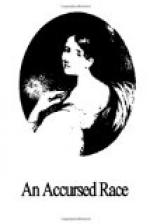Of course, the inhabitants of Biarritz were all the more ferocious for having been conquered; and, four years later, a carpenter, named Miguel Legaret, suspected of Cagot descent, having placed himself in the church among other people, was dragged out by the abbe and two of the jurets of the parish. Legaret defended himself with a sharp knife at the time, and went to law afterwards; the end of which was, that the abbe and his two accomplices were condemned to a public confession of penitence, to be uttered while on their knees at the church door, just after high-mass. They appealed to the parliament of Bourdeaux against this decision, but met with no better success than the opponents of the miller Arnauld. Legaret was confirmed in his right of standing where he would in the parish church. That a living Cagot had equal rights with other men in the town of Biarritz seemed now ceded to them; but a dead Cagot was a different thing. The inhabitants of pure blood struggled long and hard to be interred apart from the abhorred race. The Cagots were equally persistent in claiming to have a common burying-ground. Again the texts of the Old Testament were referred to, and the pure blood quoted triumphantly the precedent of Uzziah the leper (twenty-sixth chapter of the second book of Chronicles), who was buried in the field of the Sepulchres of the Kings, not in the sepulchres themselves. The Cagots pleaded that they were healthy and able-bodied; with no taint of leprosy near them. They were met by the strong argument so difficult to be refuted, which I quoted before. Leprosy was of two kinds, perceptible and imperceptible. If the Cagots were suffering from the latter kind, who could tell whether they were free from it or not? That decision must be left to the judgment of others.
One sturdy Cagot family alone, Belone by name, kept up a lawsuit, claiming the privilege of common sepulture, for forty-two years; although the cure of Biarritz had to pay one hundred livres for every Cagot not interred in the right place. The inhabitants indemnified the curate for all these fines.
M. de Romagne, Bishop of Tarbes, who died in seventeen hundred and sixty-eight, was the first to allow a Cagot to fill any office in the Church. To be sure, some were so spiritless as to reject office when it was offered to them, because, by so claiming their equality, they had to pay the same taxes as other men, instead of the Rancale or pole-tax levied on the Cagots; the collector of which had also a right to claim a piece of bread of a certain size for his dog at every Cagot dwelling.




